Contemplating Hopniss, the American Groundnut
February 13, 2014 | Updated May 21, 2020
As an Amazon Associate I earn from qualifying purchases.

When I look at a big bowl of freshly dug American groundnuts, I think of what might have been, and what may yet be.
American groundnut, also called hopniss, if you’ve never heard of it, is the North American answer to the South American potato. It is a tuber from a bean plant, and yes, you can eat the beans and flowers and shoots too, just the way you can with regular beans. But the tuber holds the most potential as a serious food crop.
The first European reference I can find to hopniss is from Sir Walter Raleigh’s 1585 voyage to Virginia. His resident scientist, Thomas Harriot, wrote a report following the voyage about all the potentially useful things he encountered in the New World, including:
Openauk, a kind of root of round form, some of the bigness of walnuts, some far greater, which are found in moist & marish grounds growing many together one by another in ropes, or as though they were fastened with a string. Being boiled or sodden they are very good meat…
Openauk is only one of many names this plant possesses. Apios americana is what we’re now calling it in starchy Latin binomials, but American groundnut — ironic, considering that the actual groundnut, which we call peanuts, is also of American origin — is also called vine potato, ground bean, and a host of lesser monikers. My friend and colleague Sam Thayer likes the hopniss name, and so do I. It’s clear, short and pretty.
Native to North America east of the Great Plains (although it can be found in a few spots as far west as Colorado), American groundnut likes to be in wet places: streambanks, lowland forest edges, pond edges, etc. That said, the plants are drought tolerant as well; a nice trait to possess in this uncertain climate we’ve been experiencing lately. Hopniss will also grow in gardens, as I have been doing since 2011.
The reason it’s taken me so long to write about Apios americana is the primary reason you can’t buy American groundnut in your supermarket: The tubers, to be of any decent size, need two years to mature. That is simply too long if you are growing for the market. Hopniss tubers also grow like a string of peanuts along the root system of the plant, and can be found yards away from where the plant is growing. Another problem if you plan on growing them en masse.
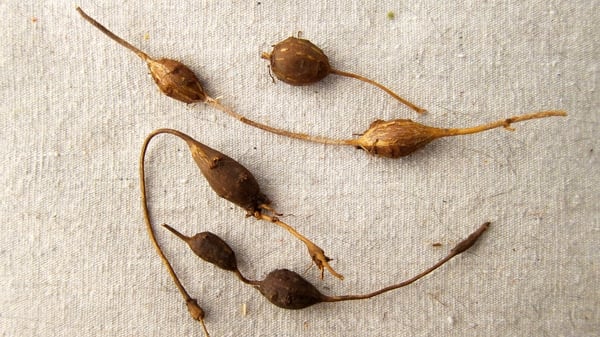
Sam, like most Eastern foragers, prefers to forage for hopniss rather than grow it for precisely this reason. He can harvest a bushel bag in a couple hours from the wild, needing only a shovel and the knowledge of a good spot. Hopniss are easy to spot when they are growing. They basically look like any bean you might encounter in a garden, and they smell beany.
As they are perennials, you can spot older plants by looking at the leaf stems: Older plants have more leaflets on that stem then younger ones. If you can trace a vine back to the soil, the vine will be thicker at the soil line in older plants, too. Late in summer and in early autumn, hopniss sports gorgeous, edible flowers.
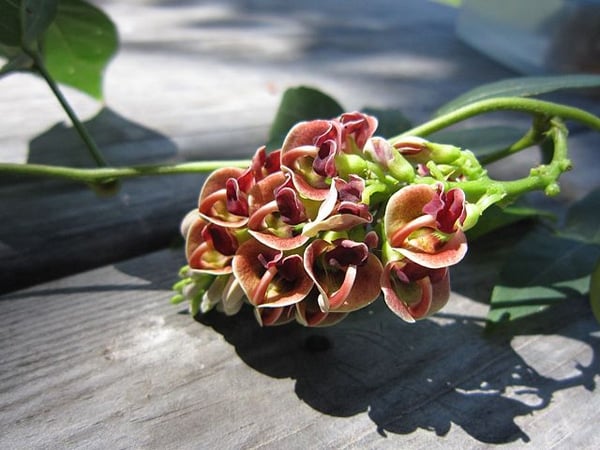
Those flowers become beans, which are edible if you cook them. Like most beans, both the beans and American groundnut tubers contain protease inhibitors, a sort of “anti-nutrient” that steals nutrition from you if you eat them raw. So cook them, OK?
It’s the tubers you want, though. And here’s the first advantage of hopniss: You can harvest them pretty much whenever the ground is not frozen, although most sources say they are sweetest in late fall and early spring. February is a perfect harvest time for them here in California.
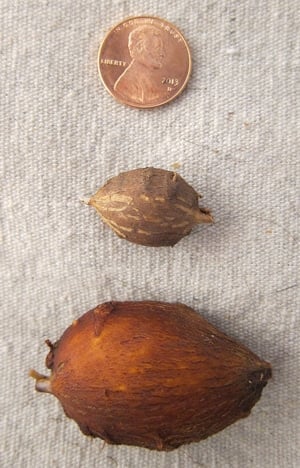
A typical hopniss tuber is, as Harriot mentioned 425 years ago, about the size of a walnut. That, mind you, is a two-year-old tuber. They get bigger, though, and Sam Thayer has found a few larger than the largest potato. Who knows how old that one was! In my garden, I keep tubers larger than an almond and return the smaller ones to the ground, where they will regrow.
How to eat them? Look first to the Indians. Virtually every native group living where hopniss lives used the plant in some way, shape or form. The Cherokee liked the beans. The Menominee cooked the tubers with maple syrup. The Dakota used them like potatoes.
Some sources say to peel the tubers, but I find this is only necessary with really big, old tubers — you can eat those skins, too, but they’ll make you farty. I also tend to peel the tubers because I like their pretty ivory color.
What are they like? At first taste, they are remarkably close to floury potatoes like Russets. The tuber is a little drier than a potato, quite a bit sweeter — but nothing like a sweet potato — and has a definite beany quality. It really is a bean-potato.
Hopniss is denser than a potato so it will require a bit longer to cook. I find that typical tubers take about 30 minutes to get to the “easily mashed” point. They do not reheat well, however. Reheated hopniss gets gluey and gummy. You can (and I have) however eat leftover mashed hopniss at room temperature and it’s fine.

American groundnut also fries wonderfully, making some of the finest potato chips or crisps you’ll ever eat. Because they are drier than potatoes, they cook fast and crisp easily. Cut them a little thicker than you would a potato so they don’t dry all the way through. And make sure to salt them the second they come out of the oil or the salt won’t stick.
You can also dry the tubers to make a sort of flour. Both the Mohegans and the Delaware Indians preserved hopniss; hopniss, incidentally, is the Lenape world for the plant. I didn’t peel my tubers when I made flour, so it took on a warm gray hue.
To make the flour I sliced the tubers into discs and dehydrated them completely. Then I put them into my Vitamix blender and kicked the spurs to it. Instant flour. If your blender is not so muscular, you might need to grind it in some other way.
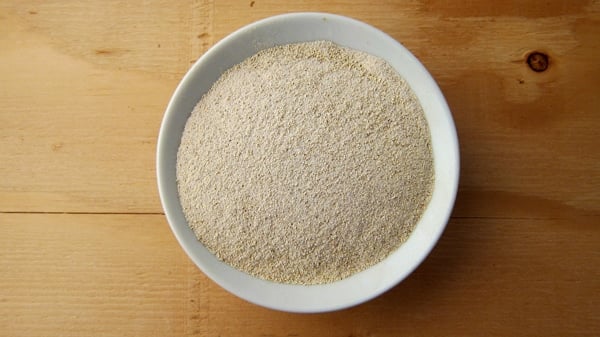
You can use this flour in any number of ways. The Delaware Indians used it to thicken soups and stews, and it works like a charm. Hopniss flour absorbs a huge amount of water by weight — far more than wheat flour. In this respect it’s a lot like potato flour (which is not the same thing as potato starch, so be careful when you look up recipes).
But if you think about it, hopniss flour is every bit as much a bean flour as it is a “potato” flour. So use it where you might use chickpea flour, such as in an Italian farinata. This is a hopniss farinata with a hopniss skordalia to serve next to it.
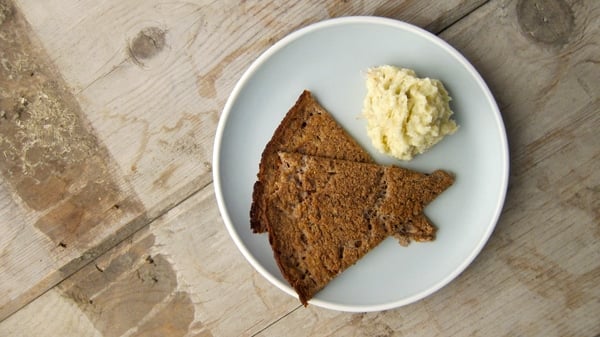
Skordalia is a Greek dip made from potatoes and garlic, oil and vinegar. It’s basically really loose garlic mashed potatoes with some vinegar. (Recipe follows) Done with hopniss, it’s spectacular. The farinata are good — they taste like the crust on wheat bread — but they need the skordalia to be a real treat.
For now, the only way you will get your hands on hopniss is to forage or grow them yourself. And if you grow them, it will be a long, often frustrating endeavor. But it may not be like that for long.
For a brief, shining time, scientists at Louisiana State University worked to improve yields and tuber set on Apios americana. It worked, and they got up to 7 pounds of tubers per plant in one season. But sadly, that research ended and has only recently been picked up by the plant geeks at Iowa State University. Slowly, improved hopniss tubers are becoming available.
My great hope is to see hopniss become more widespread. It is more than just a potato substitute. It is a world-class food plant that happens to be native to the United States. And that’s a good thing.


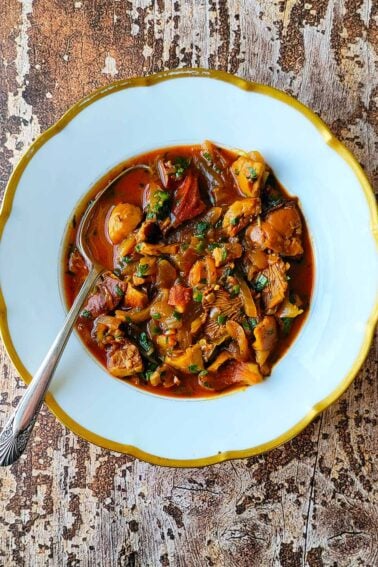

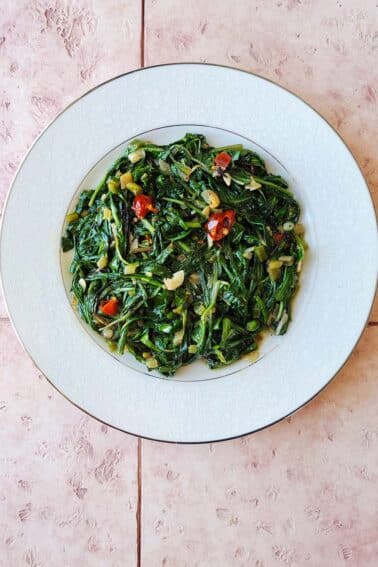
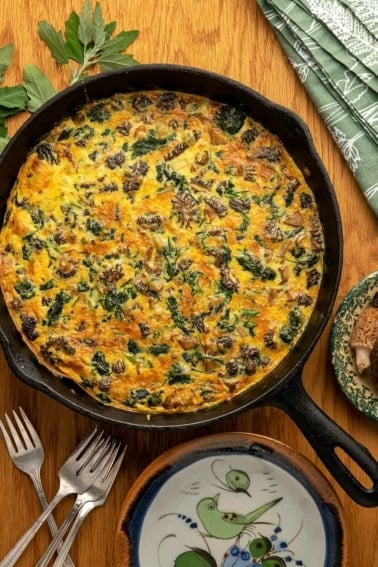
I just found some apios americana plants growing in a wetland area near my home in SE Wisconsin. so excited about possibility of trying out the tubers and maybe the nuts. Have to ask the property owners if they mind my digging for some tubers. am guessing they’ll think I’m crazy
Loved reading this article and the comments with everyone’s experiences with this plant. I bought tubers a few years ago, the vines grew very long and bloomed last year. This year the vines grew but no blooms, what is up with that? Anybody have any ideas?
Trend: Mine only blossoms periodically.
Wonderfully written article. The description, history, and variation of recipes, great read. We are attempting to grow hopniss here. It’s interesting some people reporting a developed allergy over time, perhaps build-up of a certain protein? I wonder if there is something that could be added to improve digestibility? Similar to how savory was/is added to improve bean digestibility.
I was just last night reading Henry David Thoreau’s Walden and ran across his lament of the demise of the ground nut due to over-foraging. Came here as I was scrounging for news of its plight. Glad to hear it’s still a thing.
William: Very much so! I never knew there was a time when people overharvested them. Interesting.
Hey Hank! You think we have them in the woods of North Texas?
Steve: Not sure, but I am pretty certain they are in east Texas.
I discovered this at the hotel I manage in Portland, Maine. At first I thought it was a weed that was choking out my day lilies, then one that I missed bloomed those gorgeous pink flowers. So I posted it on Facebook to see if anyone knew what it was, and my friend told me that it was American Groundnut! So fascinating, I’m having fun learning more about it. Thanks everyone!
Great article. I have been growing hopniss in my garden for several years but have to get enough to eat. I love the flowers and let them grow up the stalks of another great native Jerusalem artichokes. I will have to try some of your suggestions.
Hi, it is mentioned the tubers should be cooked (boiled) for ~30 minutes. Is this not necessary when making chips?
Chris: nope, because the slices are so thin they cook through quickly.
How do you process and cook the beans?
I was unable to sign up for your email newsletter, carriegerenscoggins@gmail.com , put my email on the list.
End Times Prophecy News Update,
Carrie Geren Scoggins
Do deer eat the green plants too. We have deer which prevent us from growing Hosta and Echinacea and several other plants. From what I read, ‘our’ deer are less fussy and eat more types of flowers than some deer.
I have had them in my yard for about 8 years now and let them grow where they want, trimming the vines when they get too thick while growing up my wild asparagus or my cardinal flowers that surround my pond. They can grow like crazy. I have roasted them (tasted like chestnuts – I definitely prefer them peeled!) and boiled. When I roasted them still on their strings, I just crack the skin and then scrap the meat out with my teeth like a snack. The deer love the dried foliage during winter.
I don’t know where my plants came from but for the last few years they are spreading like crazy. I don’t mind, i have the space and the flowers are beautiful. Next spring I will dig some tubers and cook them.
From “https://orionmagazine.org/article/stalking-the-wild-groundnut/”
“I have to tell you, since I’ve been feeding people hopniss all these years, I’ve found out some of them will get violently ill after eating it.” It had never happened the first time someone tried it, he said, but it could happen the second time or even after many years of eating it. “Maybe you need to build up a certain dose of the protein. Maybe there’s more of this allergen in larger tubers. Or it might have to do with the growing conditions.” He estimated that as many as 5 percent of Apios americana eaters would be made sick at some point and, once they reacted, would become ill with every subsequent bite. “That’s the only thorn on this rose. Otherwise, it would be a perfect food.”
My family of 8 has eaten grown and eaten groundnuts for the last few years. I really enjoyed them, and we probably ate them at least a dozen times per year, maybe more. Then a few months ago we ate some that maybe hadn’t gotten cooked quite as long as usual and everyone in my family except me got sick. This was after having eaten them dozens of times over multiple years. One member of my family that got sick was brave enough to try them another time, very well cooked, but she got sick again, as someone had told us to expect. I’m now inclined to believe that it’s not just a small percentage of the population that’s susceptible, but that improper cooking — and after years of eating them I still don’t really even know what defines proper cooking — can sensitize most anyone to them, after which they’ll get sick no matter how they’re cooked. I know they were a very common food for American Indians — a story I read of a Massachusetts woman that was taken captive in King Philip’s War in colonial days and held as a slave by the Indians for about a year mentioned them repeatedly and described them as perhaps the Indians primary food source — but as much as I’d like to continue eating them, I feel like there’s an important secret that the Indians must have known that I don’t know how to uncover. They are really good (in a plain, starchy vegetable kind of way.)
Are there any toxic or undersirable look-alikes? I have tons of this stuff growing all over my farm in Wisconsin (yes, low land close to a trout stream) and I want to make sure I have a positive ID or a very low chance of failure to recognize evil before I proceed to trying to eat some.
Chuck: Not that I know of, and those tubers are very distinct. Maybe dig some and post a picture to our Facebook group, Hunt Gather Cook? https://www.facebook.com/groups/huntgathercook/
In the post you mention the flowers are edible, since groundnuts do not produce seedpods in my area (which is near its northern limit in the east) I’m especially interested to give these fragrant large flowers a try in salad and possibly also cooked.
You can dry the flowers of at least some of the Pea family members for tea and other uses – one example being clover, has anyone any first hand experience with dried groundnut flowers?
Gary: I’ve never dried them. I just eat them fresh, as a beany garnish.
The plants can be found in abundance in many places on the wooded banks of the Mississippi River, in Tennessee. As someone else mentioned, when the river is high and scouring the banks, then drops, many of the tubers are left lying exposed. They also grow thickly in the forests around the swamps here, and be spotted by the flowers at a time when nothing else around the swamps is blooming.
On the subject of developing allergies: I have never had any known food allergies but fear I may be developing one to Apios americana tubers. I love this wild food and it pains me to think I might not be able to eat it any more. But since we’re gathering data points, here’s what happened. I’ve eaten it several times with no ill consequences. After 5 or 6 times, I combined it with evening primrose tubers and became ill several hours later. My friend (who ate the same dish did not). I assumed it was the evening primrose, since I’d never eaten that tuber before. Last fall I hash browned the Apios tubers on their own and was violently ill within a half hour. It passed quickly but was very unpleasant. I suppose I’ll have to try it again, with a longer cooking prep, to test the theory and I’m not eactly looking forward to that. I’d be very interested in hearing from anyone else with this experience.
Hi Hank,
Love your article. Thoreau wrote about hopniss [Apios Americana] in his book ‘Wild Fruits’ . Seems to me this native plant is a great addition to a wetland permaculture garden.